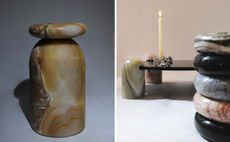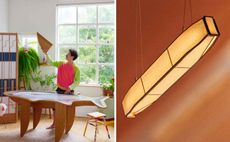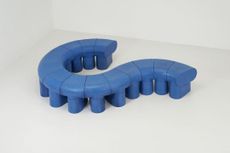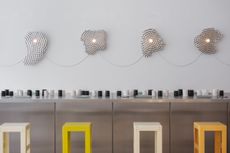Giles Nartey translates African rituals into bold design objects
Future Icons: Giles Nartey's boundary-pushing work combines teaching, research and design

‘African craft cultures are a catalyst for re-imagining the spaces we live in’ says Giles Nartey. Through his work the British-Ghanian architect seeks to celebrate Black identity, traditions, and culture. Moving between art, film, and architecture his research-based practice aims to translate African rituals into bold design objects.
Giles Nartey: academia meets design

'Interplay', a communal bench embedded with the Ghanaian game ‘Oware'
Born in South London, Nartey spent almost a decade of his early life in Accra, Ghana. ‘Growing up in Labadi I was inspired by the informal architecture, behaviours and practices that animated structures,’ says the designer. Seeing practices such as people washing their hands in a bowl before a meal or the grinding of peppers in an Asanka (wooden grinder), continue to influence the work of the London-based designer today.
Having studied at Politecnico di Milano and the Bartlett School of Architecture, academia has always played a vital role in Nartey’s life. At present, he lectures at the University College London and co-runs a diploma unit at the AA with architect, writer, and educator Nana Biamah-Ofosu. ‘My aim is to always teach, research and practice as a designer. This combination provides me with the tools to push boundaries in my work.’

Currently, undertaking a PhD at the Bartlett School of Architecture, academia also serves as a testing ground for the British-Ghanian lecturer. 'Interplay' is a direct output of much of his doctorate research into African ontologies. First exhibited at POoR’s Powershift exhibition at the London Design Festival in 2023, this striking piece of seating rethinks furniture as a shared skin, with engraved and overlapped narratives occupying its marked surface. ‘The piece takes reference from traditional West African Senufo carved bed-bench which are traditional carved out of a single piece of timber’ explains Nartey.
Embedding the Ghanaian game ‘Oware,’ Interplay is a communal bench which allows for performative interaction. ‘Historically African objects have been miscategorised as inanimate artefacts, but most were part of rituals and practices from the spiritual to the domestic either in the making or the use.’

‘To date, exhibiting Interplay in the Victoria and Albert Museum for the Friday Late: Radical Imaginaries is one of my greatest career moments. The V&A is a place my mother would take me and my sisters when we were younger, so it meant a lot to exhibit a piece of work so tied to our heritage and shared family memories there.’
Continuing the same body of thought as Interplay, Nartey’s latest work is a sleek six-legged aluminium stool titled ‘Serwaa.’ A contemporary manifestation of the West African Lobi chair, this sculptural piece speaks to spirituality across present-day Burkina Faso, Cote D'Ivoire and Ghana. This stylish seat will be followed by a clever series of architectural interventions in Accra which reimagine food kiosks, the market, and the way in which produce is sold on the street.
Wallpaper* Newsletter
Receive our daily digest of inspiration, escapism and design stories from around the world direct to your inbox.
Rooted in traditional West African culture, the work of Nartey is helping to shift the global design canon. Using academia as a launchpad, he is creating forward-thinking objects that speak to traditional Ghanian rituals. ‘My aim is to imagine African design not as a relic or artefact but as contemporary language steeped in the practices that fostered its creation.'

'Ayie': Recently installed at 22 Gordon Street, the work was erected primarily for a series of filmed performances exploring the relationship between crafted objects and the embedded rituals which infuse them with meaning. ‘Ayie’ refers to the Akan term for funeral rites practiced in Ghana where a codified range of black, red and black & white fabrics are worn. The work touches on the inherited colonial legacy of dutch wax fabric and also captures through moving image the paradoxical condition of celebrating while mourning.
Shawn Adams is an architect, writer, and lecturer who currently teaches at Central St Martins, UAL and the Architectural Association. Shawn trained as an architect at The Royal College of Art, Architectural Association and University of Portsmouth. He is also the co-founder of the socially-minded design practice Power Out of Restriction. In 2023, POoR won the London Design Festival’s Emerging Design Medal. Shawn writes for numerous international magazines about global architecture and design and aims to platform the voices of those living across the Caribbean, Asia, and Africa.
-
 Rick Owens’ new Moncler collaboration features a surreal ‘demountable mountain refuge’ inspired by Charlotte Perriand
Rick Owens’ new Moncler collaboration features a surreal ‘demountable mountain refuge’ inspired by Charlotte PerriandYour first look at Rick Owens’ latest Moncler collaboration, a mountain refuge designed alongside extreme-condition experts Hugh Broughton Architects and an accompanying clothing collection made for ‘hibernating’
By Jack Moss Published
-
 The new Ford Capri wants to tap a vein of Gen X nostalgia. Does it succeed?
The new Ford Capri wants to tap a vein of Gen X nostalgia. Does it succeed?We ask if the all-electric Ford Capri can capture the swagger of its much-loved but rather oafish predecessor
By Guy Bird Published
-
 Rug designer Sibylle de Tavernost’s homage to Fernard Léger
Rug designer Sibylle de Tavernost’s homage to Fernard LégerAbstract modern art, craft heritage and contemporary life fuse in Sibylle de Tavernost's new limited-edition rugs
By Harriet Thorpe Published
-
 Josh Egesi on his designs and evolving culture: 'Design is a form of cultural documentation'
Josh Egesi on his designs and evolving culture: 'Design is a form of cultural documentation'Nigerian designer Josh Egesi tells Wallpaper* about the creativity behind his studio, design approach, his country's cultural revolution, and venturing into surfboard design
By Mazzi Odu Published
-
 Panorammma's design work is a combination of fictional worlds
Panorammma's design work is a combination of fictional worldsWallpaper* Future Icons: Mexico City-based design studio Panorammma is the practice of 29-year old Maika Palazuelos
By Francesca Perry Published
-
 Olivia Bossy's sculptural furniture is inspired by everyday moments
Olivia Bossy's sculptural furniture is inspired by everyday momentsWallpaper* Future Icons: based in Sydney Olivia Bossy turns visuals and ideas into sculptural furniture
By Rosa Bertoli Published
-
 Rio Kobayashi turns traditional furniture making on its head
Rio Kobayashi turns traditional furniture making on its headWallpaper* Future Icons: how Austrian-Japanese designer Rio Kobayashi reinvents traditional furniture through diverse influences and collaborations
By Rosa Bertoli Published
-
 Rino Claessens’ modular furniture experiments with ceramic design
Rino Claessens’ modular furniture experiments with ceramic designWallpaper* Future Icons: Rino Claessens turns his love for ceramics into experimental large-scale modules and compositions
By Jasper Spires Published
-
 Inside Seongil Choi's experiments with materials and form
Inside Seongil Choi's experiments with materials and formWallpaper* Future Icons: Seoul-based Seongil Choi works across a variety of materials, with experimental approaches at the heart of his work
By Rosa Bertoli Published
-
 Parti Studio swing between architecture and design through research and experimentation
Parti Studio swing between architecture and design through research and experimentationWallpaper* Future Icons: London-based architecture practice Parti made its lighting design debut this year
By Sujata Burman Published
-
 Matan Fadida's work merges comfort and formal experimentation
Matan Fadida's work merges comfort and formal experimentationWallpaper* Future Icons: based in London, Matan Fadida's work can be described as industrial minimalism achieved with honest materials, and includes objects, furniture and wearables
By Francesca Perry Published